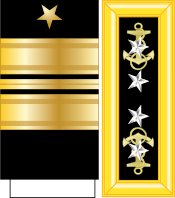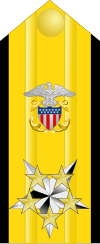Admiral of the Navy (United States)
The Admiral of the Navy (abbreviated as AN) is the highest possible rank in the United States Navy. The rank is equated to that of a six-star admiral and is one of the two highest possible military ranks in the United States Armed Forces. It has only been awarded once, to George Dewey, in recognition of his victory at Manila Bay in 1898.
| Admiral of the Navy | |
|---|---|
 Insignia for Admiral of the Navy (1899–1917) | |
| Country | |
| Service branch | |
| Abbreviation | AN |
| NATO rank | OF-10 |
| Non-NATO rank | Six-star rank |
| Formation | 1903 (retroactive to 1899) |
| Next higher rank | None |
| Next lower rank | Fleet admiral |
| Equivalent ranks | General of the Armies (U.S. Army) |
History
Post-Spanish American War

The rank has only been awarded once, to George Dewey, in recognition of his victory at Manila Bay in 1898. On March 2, 1899, Congress approved the creation of the grade of Admiral of the Navy.[1] On March 3, President McKinley transmitted to the Senate his nomination of Dewey for the new grade, which was approved the same day.[2] But McKinley's nomination had used the term "Admiral in the Navy," while the act creating the new grade had used "Admiral of the Navy." On March 14, 1903, this discrepancy was addressed when President Roosevelt nominated and the Senate approved Dewey to the grade of "Admiral of the Navy," retroactive to March 2, 1899.[3] The Navy Register of 1904 listed Dewey for the first time as "Admiral of the Navy" instead of "Admiral."[4]
Though this clarified the grade's unique title, the precedence of the new rank was still considered "four star", equivalent to general in the army, in the US Navy Regulations of 1909.[5] In the US Navy Regulations of 1913, perhaps in anticipation of legislation to authorize more admirals, the precedence of Admiral of the Navy had been set at the "five star" level, equivalent to a British field marshal or admiral of the fleet.[6] More four-star officers were appointed after an act authorizing the temporary grade of admiral for three fleet commanders-in-chief was passed in 1915. [7]
In terms of insignia, Dewey appears in a photograph soon after his promotion wearing the sleeve stripes last worn by Admiral David Dixon Porter, which are the same as present-day admirals (one two-inch band with three half-inch stripes above). When a new edition of US Navy Uniform Regulations was issued in May 1899, the sleeve insignia for admiral was specified as "two strips of 2-inch gold lace, with one 1-inch strip between, set one-quarter of an inch apart."[8] In the 1905 Uniform Regulations, a similar description was used but with the title "Admiral of the Navy."[9] The collar and shoulder insignia were four silver stars, with gold foul anchors under the two outermost stars.
Post-World War II

In 1944, with the establishment of the rank of fleet admiral, the Department of the Navy specified in a Bureau of Navigation memo that "the rank of Fleet Admiral of the United States Navy shall be considered the senior most rank of the United States Navy". As George Dewey had been deceased for nearly thirty years, no comparison between his rank and that of fleet admiral was made until 1945. At that time, during the preparations for Operation Downfall, the proposed invasion of Japan, the possibility was raised of promoting one of the serving United States Fleet Admirals to "six-star rank" should the Army take a similar measure by promoting Douglas MacArthur to the rank of General of the Armies.
In 1981, upon the death of Omar Bradley, the United States House Committee on Armed Services inquired of the Institute of Heraldry as to the procedure should a navy officer ever be awarded a six-star rank equivalent of General of the Armies. The response to Congress stated:
Should an officer of the Air Force or Navy be promoted to six-star rank, that officer should be entitled to the six-star insignia with a service specific crest.[10]
While the Institute did not specifically mention the rank of Admiral of the Navy, a prototype shoulder board for a "Navy six-star admiral" was designed in sketch. This image was later made available through the Naval History and Heritage Command. The insignia did not address the sleeve stripe insignia for such a rank and only provided details for the shoulder boards typically worn on summer and full dress white uniforms.
Text of Act
The act to create the grade of Admiral of the Navy read as follows:
Be it enacted by the Senate and the House of Representatives of the United States of America in Congress assembled, That the President is hereby authorized to appoint, by selection and promotion, an Admiral of the Navy, who shall not be placed upon the retired list except upon his own application; and whenever such office shall be vacated by death or otherwise the office shall cease to exist.[11]
References
- Pub.L. 55–378, 30 Stat. 995, enacted March 2, 1899 (An Act Creating the office of Admiral of the Navy)
- U.S. Congress, Journal of the Executive Proceedings of the Senate, Volume 31 pt.2 1897-1899.
- U.S. Congress, Journal of the Executive Proceedings of the Senate, Volume 34 1902-1903.
- U.S. Department of the Navy, Register of the Commissioned and Warrant Officers of the Navy of the United States and of the Marine Corps, 1900 et seq.
- U.S. Department of the Navy, Regulations for the Government of the Navy of the United States, Government Printing Office, 1909. Page 39.
- U.S. Department of the Navy, Regulations for the Government of the Navy of the United States, Government Printing Office, 1913. Article 1126.
- "An Act Making appropriations for the naval service for the fiscal year ending June thirtieth, nineteen hundred and sixteen, and for other purposes.". 63rd Congress Chapter 83, Act of 3 March 1915 (PDF).
- U.S. Department of the Navy, Regulations Governing the Uniform of Commissioned Officers, Warrant Officers and Enlisted Men of the Navy of the United States, Government Printing Office, 1899.
- U.S. Department of the Navy, Regulations Governing the Uniform of Commissioned Officers, Warrant Officers and Enlisted Men of the Navy of the United States, Government Printing Office, 1905.
- Congressional Record 1981, Cong. 97 Sess. 1 – Part 8, "Promotion of other service branches to General of the Armies of the United States".
- CHAP 378, "An act creating the office of Admiral of the Navy", United States Congress